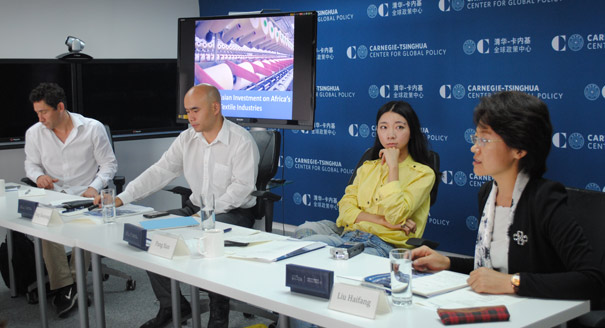Registration
You will receive an email confirming your registration.
The investment of Asian firms in Africa’s cotton, textile, and apparel sectors could be both a boon and a hindrance for the continent’s own internal production. On the one hand, the arrival of Asian apparel and cotton manufacturers in Africa provides access to more modern technology and advanced management techniques that can benefit local producers. On the other hand, local producers are struggling in the face of cheaper cotton imports from Asia.
Carnegie–Tsinghua hosted a panel discussing the cotton-textile-apparel production chain in Africa, as analyzed by Carnegie–Tsinghua’s Tang Xiaoyang in his latest paper, “The Impact of Asian Investment on Africa’s Textile Industries.” Following his presentation, Liu Haifang of Peking University and Pang Xun, the co-director of the Carnegie-Tsinghua Center, gave their remarks. Jeremy Goldkorn of Danwei moderated the discussion.
Discussion Highlights
- The Flying Geese Model: Participants discussed the driving role of textiles in both the nineteenth-century industrialization of the United Kingdom and in the later industrialization of Japan and other Asian-Pacific countries. The Flying Geese Model, as explained by participants, is a phase of industrialization in which developing countries begin with labor-intensive industries—such as cotton and textile production—as a precursor to more capital-intensive sectors. The wealth, knowledge, and technology that countries acquire from developing labor-intensive industries can then serve as a means to shift production gradually into more complex industrial sectors. Meanwhile, labor-intensive production then moves to other developing countries. Participants praised the utility of the Flying Geese Model for examining African industrialization and the importance of textile production. However, panelists speculated that a uniquely African model may be more insightful.
- Expiration of the Multifibre Arrangement : From 1974 until the end of 2004, a strict quota system governed the world textile market and imposed restrictions on textile imports from developing countries. According to participants, a high world price for textiles encouraged the development of a thriving African textile sector that exported its products to Western nations. After this agreement lapsed, however, a quote-free market allowed China and other Asian nations to increase textile exports and drive world prices downward. Participants explained how Asian textiles overwhelmed African textiles in both the export markets and their own domestic markets.
- Cotton-Textile-Apparel Production Chain: Under pressure from Asian competition, the cotton, textile, and apparel sectors in Africa initially shrunk dramatically after 2005. Participants analyzed each sector in-depth and discussed the current economic environment in each. Several African countries have expanded the scale of their cotton exports, some of them exceeding pre-2005 levels. In addition, cotton production facilities are improving throughout the region. In both the textile and apparel industries, markets have become more competitive, but businesses have survived in niche markets. Participants discussed how the small-scale operations of African enterprises are flexible and able to adapt to both fashion trends and demand for traditional goods. On a large scale, however, textile production is a weak point in African development. Most African countries are unable to compete with Asian textiles, due to textile production’s high upfront and maintenance costs and intense competition from foreign producers. Participants explained that African countries currently export cotton to Asia and import apparel from China. The panelists were optimistic about ongoing African industrialization.
- Asian Investment in African Industrialization: As Asian production costs—particularly wages –—increase, manufacturers seek to relocate production to lower-cost countries to stay competitive. Africa’s rich concentration of natural resources and low labor costs present a very attractive investment opportunity for Asian investors. Participants explained that large Asian investors are able to afford the large upfront costs of constructing large-scale industrial production facilities. The participants argued that these industries can play a vital role in facilitating the exchanges of knowledge, wealth, and technology that are necessary for African modernization. However, panelists did not reach consensus on the effectiveness of foreign investment.
- Policy Recommendations for African Nations: Billions of dollars are available for African nations, if they can adequately stimulate foreign investments. Participants discussed at length the challenges that currently face foreign investors, principally instability and inadequate infrastructure. Additionally, they identified actions that African governments can implement to make themselves more competitive to investors. In the short term, participants suggested subsidies and tax incentives. Long-term development goals for African countries should consist of improving infrastructure and being open to foreign cooperation.
Tang Xiaoyang
Tang Xiaoyang is a resident scholar at the Carnegie–Tsinghua Center for Global Policy and an assistant professor in the Department of International Relations at Tsinghua University. His research interests include political philosophy, China’s modernization process, and China’s engagement in Africa.
Pang Xun
Pang Xun is a resident scholar and co-director at the Carnegie–Tsinghua Center for Global Policy, where she is part of the China and the Developing World Program. Pang is an associate professor at Tsinghua University’s School of Social Sciences.
Jeremy Goldkorn
Jeremy Goldkorn is the founder and director of Danwei, a research firm that tracks Chinese media and Internet. Goldkorn also co-hosts the popular current affairs podcast “Sinocism.”
Liu Haifang
Liu Haifang is an associate professor at the School of International Studies at Peking University. Her research focuses on China-African relations, especially on the history of Chinese business operations in Africa and the perceptions of China and Chinese migrants throughout the continent.
